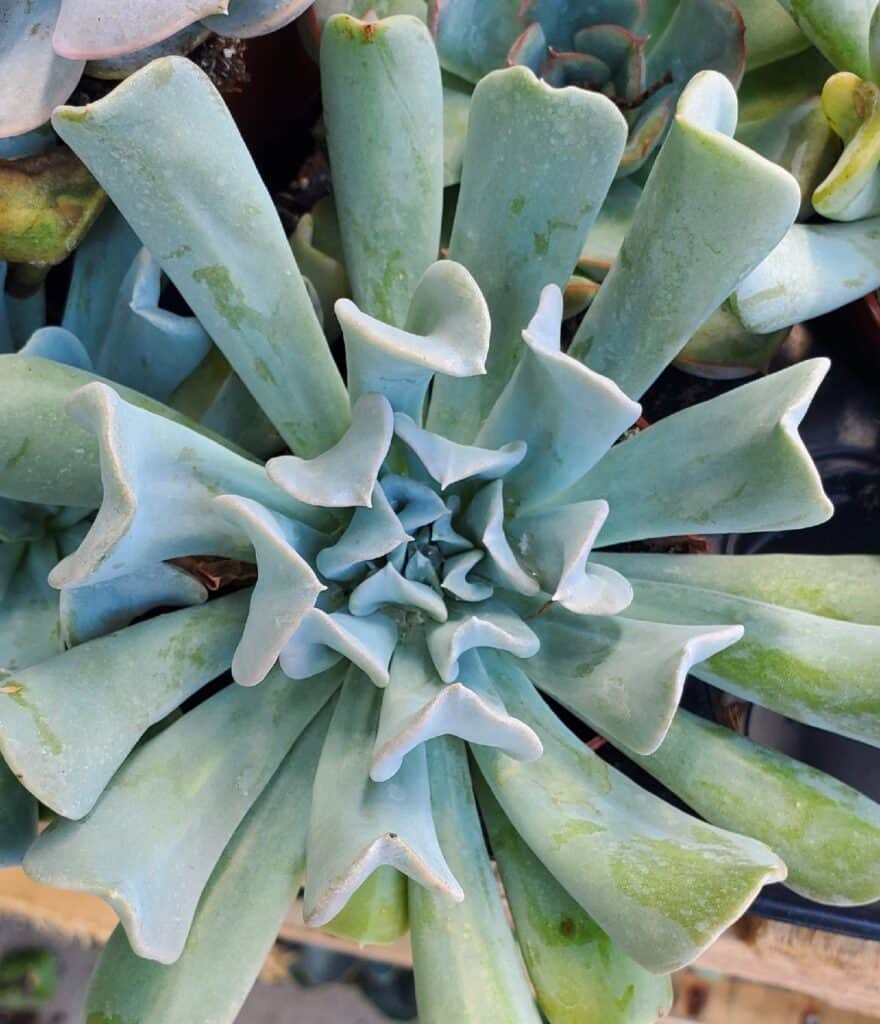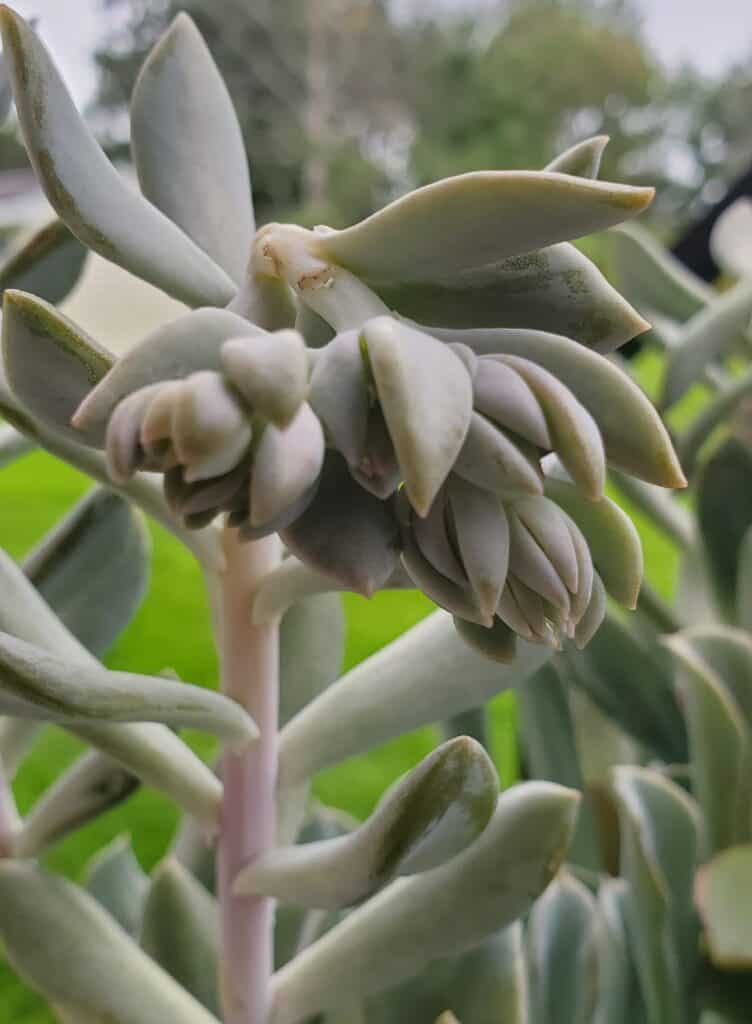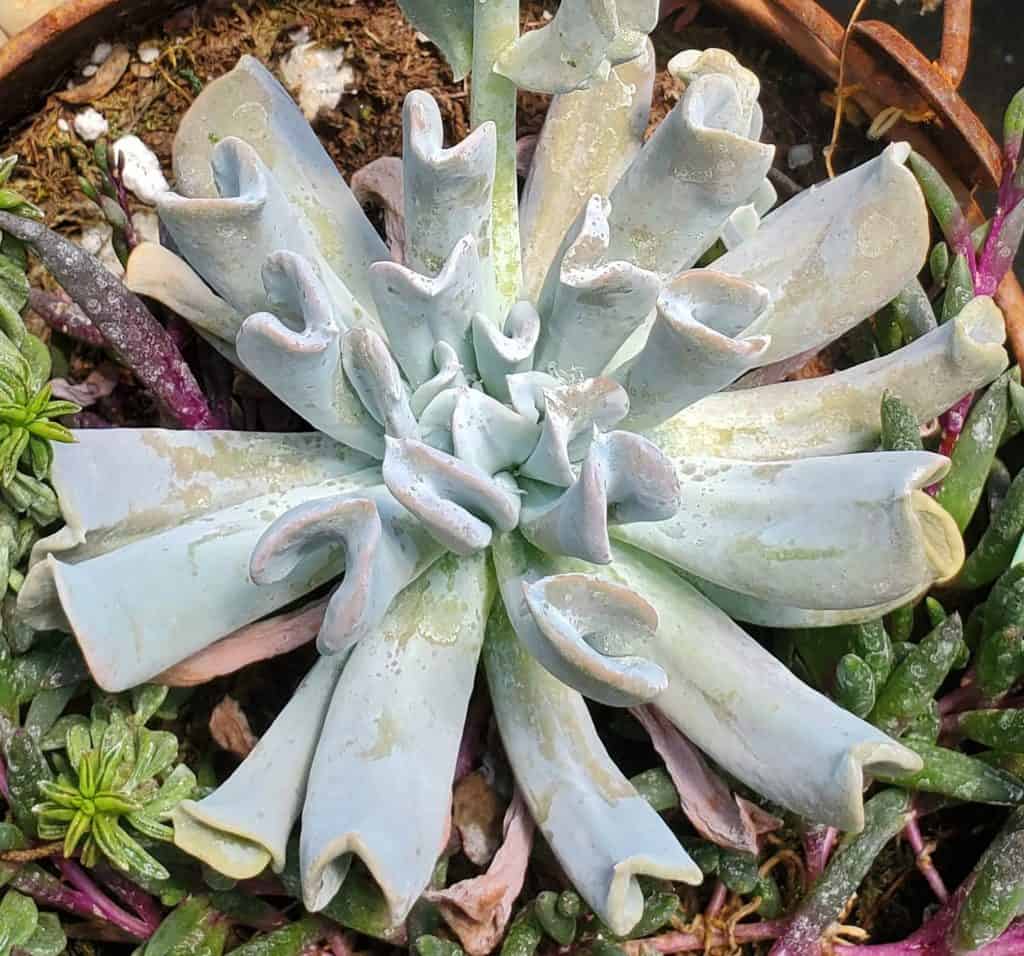Echeveria Runyonii ‘Topsy Turvy’ – Information & Complete Care Guide
I absolutely love shopping online for succulents and gardening supplies. If you aren't already saving money by comparing prices online, give it a try! Here are six of my favorite things that I have purchased online as I build my own succulent oasis:
I own two Echeveria Runyonii ‘Topsy Turvy’ with babies on the way (leaf props). These succulents are so much fun to care for, grow, and admire! And they are actually very easy to propagate which means I can continue to grow my collection for free!
If you’re new to the world of succulents, caring for an Echeveria Runyonii ‘Topsy Turvy’ might seem daunting. But the nice thing is that many types of succulents require similar care. This means once you’ve learned the basics, you’ll likely make a great succulent parent!
You’ll still want to know the nuances of each type of succulent you own because its needs can vary in terms of water, nutrients, and light needs. So before you stress out about killing your dear succulent, let’s jump into my guide on how to care for your Echeveria Runyonii ‘Topsy Turvy’ the right way.
Scientific Name
Echeveria Runyonii ‘Topsy Turvy’
Common Name
Echeveria Runyonii ‘Topsy Turvy’
Physical Description of Echeveria Runyonii ‘Topsy Turvy’

The Echeveria Runyonii ‘Topsy Turvy’ gets its name from its leaves which actually appear to be upside down. The leaves are concave and elongated, and the tips curl back toward the middle of the plant. It has beautiful, gray-green leaves that are smooth and firm in texture.
In the right environment, an Echeveria Runyonii ‘Topsy Turvy’ can grow to be about 8 to 12 inches tall and 8 to 12 inches wide. This succulent blooms small, pink and orange flowers on a long stalk, usually in the summer but can delay until early fall.

Related: How to Make Your Succulents Grow Faster and Bigger
Where to Buy Echeveria 'Topsy Turvy'
If you're looking to add more plants to your collection, you can usually buy succulents of all kinds at these stores.
Growing Season of Echeveria Runyonii ‘Topsy Turvy’
The Echeveria Runyonii ‘Topsy Turvy’ grows the most during spring and summer. If given sufficient sunlight and water, it can grow quickly during this season. It is a succulent which means it stores moisture in its leaves. It can survive temperatures as low as 25 degrees Fahrenheit but thrives in temperatures above 60 degrees Fahrenheit.
How to Care for Your Echeveria Runyonii ‘Topsy Turvy’
Caring for your Echeveria Runyonii ‘Topsy Turvy’ doesn’t need to be complicated. Here are some tips which include links to my in-depth guides for even more details.
Watering Needs of Echeveria Runyonii ‘Topsy Turvy’
The Echeveria Runyonii ‘Topsy Turvy’ prefers plenty of water at one time, but only when the soil is completely dry. I recommend using the “soak and dry” method, which means you should water your succulent until the water comes out of the drainage holes, and then let it dry out completely before watering it again.
Sunlight Needs of Echeveria Runyonii ‘Topsy Turvy’
The Echeveria Runyonii ‘Topsy Turvy’ needs plenty of sunlight to grow and thrive. It should be placed in an area where it will get 6-8 hours of sunlight per day. If you live in a hot climate, you may need to provide some afternoon shade. I keep my ‘Topsy Tury’ under a grow light for up to 12 hours per day and it’s perfectly happy.
Soil Needs of Echeveria Runyonii ‘Topsy Turvy’
The Echeveria Runyonii ‘Topsy Turvy’ needs soil that drains well which will keep its roots from rotting. A succulent mix that includes potting soil, perlite, and coarse sand is a good option. You can also make your own succulent soil by combining three parts potting soil, two parts sand, and one part perlite.
Propagation Methods of Echeveria Runyonii ‘Topsy Turvy’
You can propagate your Echeveria Runyonii ‘Topsy Turvy’ by leaf cuttings. To take a leaf cutting, slice off a healthy leaf from the succulent with a sharp, sterilized blade. Unlike most succulents that propagate by leaves, you won’t need to pull the leaf cleanly from the stem of the plant. In fact, it’s nearly impossible to do so! Instead, just cut close to the plant’s stem and allow both wounds to heal over. The detached portion of the leaf should sprout a baby.
Another way to propagate an Echeveria Runyonii ‘Topsy Turvy’ is to keep it healthy and allow it to sprout offsets. These offsets can later be cleanly cut from the base of the plant. Allow the cut to heal over and then plant it into well-draining soil.
Regardless of which propagation method you choose, it will take a few weeks for a baby to grow. Give it plenty of filtered sun, and once it has an established root system, you can start watering it like a normal succulent.
Related: How to Fertilize Succulents
Troubleshooting an Unhealthy Echeveria Runyonii ‘Topsy Turvy’

If you’re having trouble with your Echeveria Runyonii ‘Topsy Turvy’, here are some tips for troubleshooting a dying succulent.
Overwatering
Overwatering your succulent can cause root rot and certain death. Some signs to watch for include soggy soil, yellow or translucent leaves, or black roots. Cut away any black or mushy parts of the plant, remove from the soil, and set aside to dry. Once callouses have formed over any open wounds, you can repot your succulent in well-draining soil.
Underwatering
It’s not common for succulents to die from lack of water, but it does happen. If the soil is dry or compact, it may be time to water your succulent. Other indications of an underwatered succulent include brown and dry leaves at the base of the plant.
Lack of Sunlight
Most succulents need plenty of sun, and if you can’t provide it to them you can easily supplement it with a grow light. Some signs that your Echeveria Runyonii ‘Topsy Turvy’ isn’t getting enough sun include pale or yellow leaves, a leggy plant reaching toward the nearest window, or stunted growth.
Pests or Mealybugs
Pest can cause extensive damage to the roots, stems, and leaves of a succulent. In time, the plant can succumb to the pests and die. If you notice your Echeveria Runyonii ‘Topsy Turvy’ has white cotton-like patches or a sticky substance on its stem, it’s probably taken over by mealybugs. You can get rid of mealybugs using a 70% rubbing alcohol spray or a succulent-safe organic pesticide.
Echeveria Runyonii ‘Topsy Turvy’ in Review
If you’re struggling to keep your Echeveria Runyonii ‘Topsy Turvy’ alive, don’t worry! You’re not alone. But once you find out what’s pestering your succulent, it’s easy to turn things around.
In this article, I’ve gone over the basics of how to care for your Echeveria Runyonii ‘Topsy Turvy’. Make sure to compare the troubleshooting tips to your plant to determine if it’s healthy or hurting. Our plants tell us what they need in order to be happy and thrive!
Related: How to Care for Succulents Outdoors